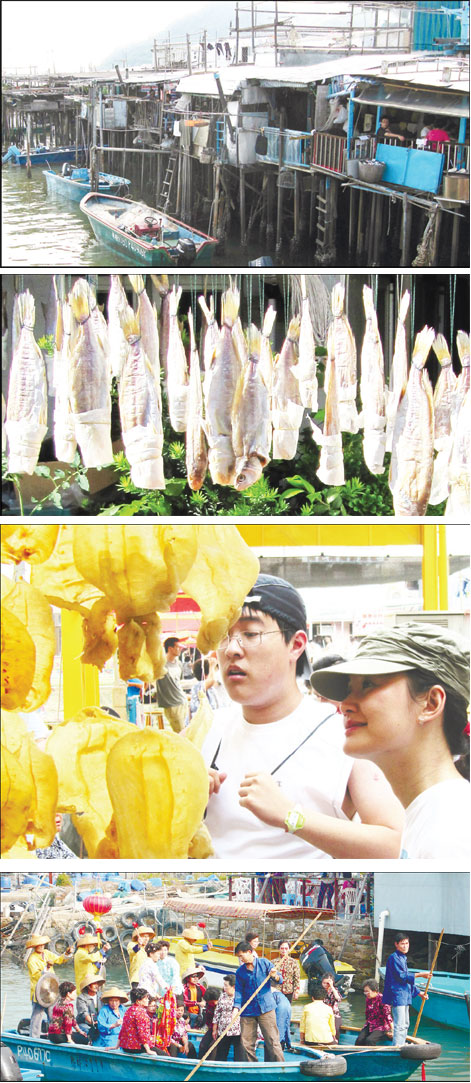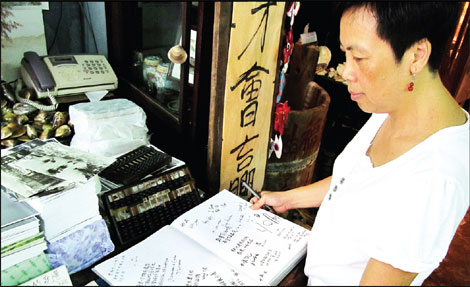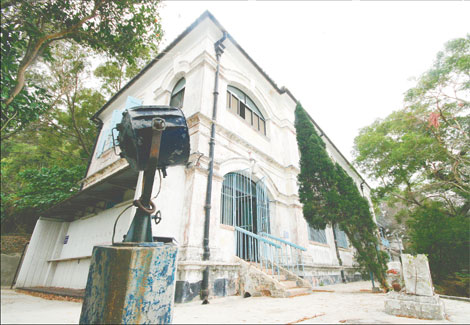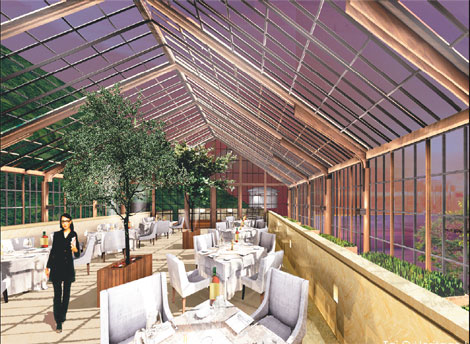The reawakening of Tai O
Updated: 2010-07-28 07:29
By Emma Dai(HK Edition)
|
|||||||||
|
The signiture features of Tai O (from top): stilt-house neighborhood, dried fish, sea food store and wedding on the boat. Emma Dai / China Daily |
Once Hong Kong's biggest fishing village, Tai O's population today is only a tenth of what it was during its peak years. The isolated island setting is becoming transformed into a weekend resort, which will include a boutique hotel, in the place where guards once stood watch on the look out for pirates. Emma Dai reports.
The old two-storey police station, having seen better years, stands on a hill overlooking the Tai O waterfront. The termites have had their day. The building where more than 200 Royal Marine and Gurkha guards watch, looking for pirates, is in disrepair. The Victorian ivory pillars of the verandah are pitted and scarred, perhaps from bullets fired during the station's days. The station remained in operation until 1996, then was abandoned to its fate where the jungle began creeping back to reclaim the land.
Tai O once boasted a population of more than 30,000 when it was Hong Kong's largest fishing village. Today the population has dwindled to around 2,700 and Tai O is finding a new purpose as a popular weekend resort. It's a peaceful place, out on island, away from the infamous din of the city - a perfect spot to catch the dawn on a sunny morning; a place where one can hear the twittering of birds and catch a glance of pink dolphin in the waves of sea.
The 108-year-old police station is to reopen next year, as a nine-suite boutique hotel. The venture sounds promising enough. It's expected to attract more than 60,000 visitors per year. Work has already begun, with treatment undertaken to rid the structure of termites. Insulation and water-proofing will be added when re-roofing. The former fire bunker will be become the wine cellar for the new restaurant. The restaurant, planned for the rooftop, will be fitted out with a glass cover, to keep out insects and extremes of tropical weather.
"We want to preserve the building, not to rebuild it," said Randy Yu, general manager of Hong Kong Heritage Conservation Foundation Limited (HCF), a non-profit enterprise backed by the property giant, Sino Group. "We will keep the simple and elegant style. The outlook will not change. You will see the building in its glory time."
Originally, Yu comes from Tai O. He was born there and spent his childhood in its environs.
The renovations on the old police station aim to preserve the station house; the old-style bullet-proof window steel; most of the wood louvers; wood blocks and fire places. "They are about 80 to 90 years old," Yu said. "But these are good wood. We will restore them as long as they are not broken."
The proposal for restoration of the station was put on the table two years ago when it was listed by the Development Bureau as one of six proposed partnership projects aimed at giving new life to historic buildings under a policy called "adaptive re-use."
After two rounds of selection, the project was authorized to HCF. The selection was probably based largely on HCF's track record for sensitive heritage restoration projects, including the Fullerton Hotel in Singapore.
"It's the culture that we mean to revitalize, not just the building," Yu said. "The hotel will be used as a platform."
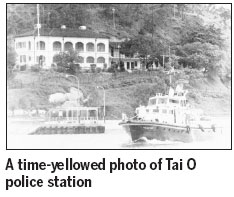
HCF is producing a documentary to record old businesses and customs. The production team interviewed more than 40 retired marine policemen who used to serve in Tai O. They've talked to the former fishermen and the sea salt makers. HCF is also working with the rural committee to help restore the water wedding, a tradition among fisher-folk that used to last two to three days but now long abandoned.
"It's like collecting puzzles to complete the culture scene," Yu said. "We promote these activities, hoping that youngsters can learn the customs and old men can flesh out memories at dinner tables. Then the traditions will be passed to the next generation."
"The company wants to pay back society," Yu added. "We will use our expertise and all the residual income to support local events and improve public facilities, making Tai O a more attractive place, to both locals and tourists."
It appears inevitable that any public enterprise attracts controversy and the renovation of the Tai O Police station is no exception. Heritage buildings are public property, which means everybody should have access. Plans call for a 30-square-meter reception area, featuring historic photos and videos, offering public access. There will be free daily guided tours of unoccupied rooms and of the grounds.
"Profit is not our priority," Yu said. "We are going to make sure everyone, both tourists and locals, get a chance to have a look at the heritage. People can also enter rooms when they are not occupied."
"Free tour? Day dream! Guests have privacy," said Wong Wai King, who, along with her husband, collects old Tai O artifacts. Her free Tai O museum contains items from children's plastic slippers to the bamboo furniture from homes of the fishermen of days gone by.
"I don't believe the hotel could give us free access," Wong said. "It's not public space. Though the government funds it, but I would not be surprised if it turned out to be an exclusive club for the rich."
If Wong's prediction proved correct, it would not be unprecedented in the history of Hong Kong's restoration of heritage buildings. The redevelopment of the former marine police headquarters in Tsim Sha Tsui, which opened as a luxury shopping center and hotel last year, has come under criticism for providing poor public access to heritage areas.
Wong, who has lived in Tai O for more than fifty years, says the police station was never open for daily visits. It would open around Christmas, she recalled. There would be carol singing on Christmas Eve. Kids were given sweets and other snacks.
To her, a police museum would be a perfect revitalization plan, though even she wonders whether visitors would be interested.
"Museums are sometimes a good way but not necessarily in every case," said Leung Yee-wah, academic director of the space cultural heritage management program of the University of Hong Kong.
"One can only feel the heritage value when it maintains its antiquity," Leung said. "The most important thing is not to let as many people in as possible, but to give those who really want to learn a chance to appreciate.
"After all, we don't preserve it for its own sake," Leung said. "The whole meaning of revitalization is to let the community appreciate and enjoy the heritage. Thus we can conserve not only the structure, but also the culture and history as well."
"If there is anyone who thinks heritage hotel is (going to be) exclusive, it's only because we have seen too many unfriendly corporate managers," Leung added. "In particular developers have little initiative to open (heritage buildings) because the authority doesn't write their leases tightly enough. A proper mechanism should be guaranteed to protect the public's right to enjoy as intended. It will really help if the authority takes a strong hand against abusing."
One is likely to encounter more dried fish than people in the famed stilt-house neighborhood. Kids who grew up in Tai O don't stay. They move away to pursue life in modern times, leaving behind them only the very old and the very young. The old ways are fading.
"I'm sad about that," said Yu, who left Tai O after primary school and now works in Kowloon. "Walking around the site remind me of the old days. I remember the carol party I've been to and those fishermen buying supplies in my father's store. It used to be popular to sail for two or three months in South China Sea."
|
Wong Wai King collects old Tai O artifacts and operates a free Tai O museum. Emma Dai / China Daily |
|
The 108-year-old Tai O police station is to reopen next year, as Tai O Heritage Hotel. Provided to China Daily |
|
An artist impression of the planned nine-suite boutique hotel. Provided to China Daily |
(HK Edition 07/28/2010 page4)
